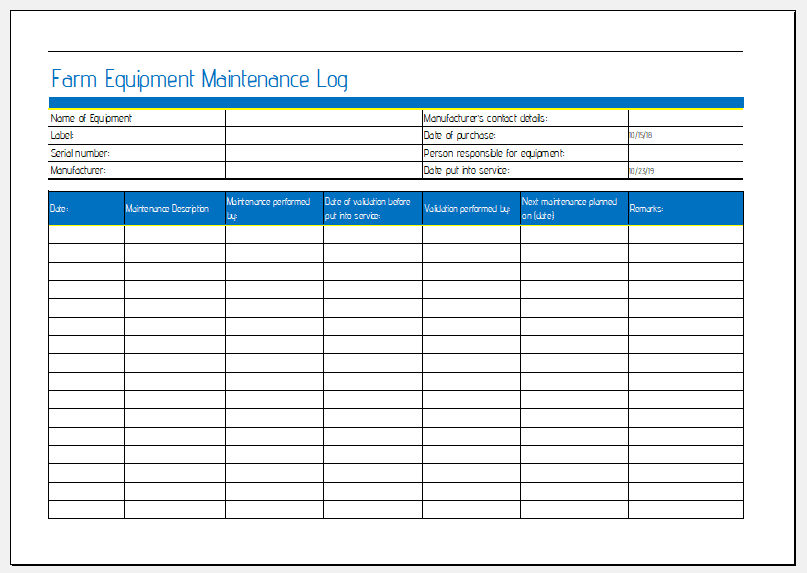
As a farmer, it is crucial to keep your equipment in top shape to ensure the smooth operation of your farm. Regular maintenance and timely repairs can prevent breakdowns and costly downtime. One effective tool that can help you stay organized and on top of your equipment maintenance is a farm equipment maintenance log. This log allows you to keep track of all maintenance activities, repairs, and inspections, ensuring that nothing slips through the cracks.
This article will explore the what, why, and how of using a farm equipment maintenance log, along with some examples, tips, and best practices for successful maintenance management.
What is a Farm Equipment Maintenance Log?
A farm equipment maintenance log is a document that allows farmers to record and track all maintenance activities performed on their farm equipment. It serves as a central repository of information, providing a comprehensive overview of the maintenance history of each piece of equipment.
This log typically includes details such as equipment identification, maintenance tasks performed, date of maintenance, parts used, and any additional notes or observations. By using a log, farmers can easily document and reference maintenance activities, ensuring that their equipment is properly cared for and serviced.




Why Use a Farm Equipment Maintenance Log?
Keeping track of maintenance activities manually or relying on memory can be challenging and prone to errors. Here are some compelling reasons why using a farm equipment maintenance log can greatly benefit farmers:
- Organization: A maintenance log provides a structured way to document and organize maintenance activities, making it easier to reference past repairs and inspections.
- Maintenance History: With a maintenance log, farmers can maintain a detailed history of each piece of equipment, including the type and frequency of maintenance performed. This information is valuable when selling or trading equipment, as it demonstrates proper care and maintenance.
- Preventive Maintenance: By regularly recording maintenance activities, farmers can establish a preventive maintenance schedule to address issues before they become major problems. This can help extend the lifespan of equipment and reduce unexpected breakdowns.
- Efficiency: A maintenance log allows farmers to quickly identify equipment that requires maintenance, plan and schedule tasks efficiently, and ensure that all necessary supplies and tools are readily available.
- Cost Savings: Proper maintenance can help identify minor issues early on, preventing them from escalating into costly repairs or equipment replacements. A maintenance log enables farmers to stay on top of maintenance tasks, avoiding expensive breakdowns and downtime.
How to Create a Farm Equipment Maintenance Log
Creating a farm equipment maintenance log is a straightforward process. Here are the steps to follow:
- Identify the necessary information: Determine the key details you want to track in your maintenance log, such as equipment identification, maintenance tasks, dates, parts used, and any additional notes or observations.
- Select a format: Decide on the format that works best for you. It can be a simple spreadsheet, a customized template, or a dedicated maintenance log software.
- Create columns and headers: Set up the columns and headers in your selected format to accommodate the information you want to record. Use clear and concise labels to ensure easy navigation and understanding.
- Add equipment details: Include essential equipment information, such as the make, model, serial number, and any other relevant identifiers that can help you quickly locate the specific piece of equipment in the log.
- Record maintenance activities: Regularly update your maintenance log by adding new entries for each maintenance task. Include the date, type of maintenance, parts used, and any additional notes or observations.
- Maintain consistency: Make it a habit to update and maintain your equipment maintenance log consistently. Regularly review the log to ensure accuracy and completeness.
Tips for Successful Equipment Maintenance Management
Managing farm equipment maintenance effectively requires attention to detail and a systematic approach. Here are some tips to help you establish a successful maintenance management system:
- Create a schedule: Develop a maintenance schedule based on manufacturer recommendations and equipment usage. Regularly review and adhere to the schedule to ensure timely maintenance.
- Train your team: Educate your farm employees on the importance of equipment maintenance and provide training on basic maintenance tasks. This empowers them to contribute to the maintenance efforts and identify potential issues.
- Document all maintenance activities: Consistently record all maintenance tasks, repairs, and inspections in your maintenance log. This documentation serves as a historical record and helps track the effectiveness of maintenance efforts.
- Regularly inspect equipment: Conduct routine inspections to identify any signs of wear, damage, or potential issues. Addressing these early can prevent more significant problems down the line.
- Use quality parts and supplies: When performing maintenance or repairs, always use high-quality parts and supplies recommended by the equipment manufacturer. This ensures optimal performance and reduces the risk of premature failures.
- Maintain cleanliness: Keep your equipment clean and free from dirt, debris, and moisture. Regularly wash and inspect your equipment for signs of corrosion or damage caused by environmental factors.
- Monitor equipment performance: Pay attention to how your equipment operates and performs. If you notice any changes in performance or unusual sounds, investigate and address the issue promptly.
Final Thoughts
A farm equipment maintenance log is a valuable tool for farmers to keep track of maintenance activities and ensure the proper care and servicing of their equipment. By using a structured log, farmers can organize and document maintenance tasks, maintain a detailed maintenance history, and establish preventive maintenance schedules.
With the right approach and consistency, a maintenance log can contribute to reduced downtime, increased efficiency, and cost savings in the long run. Implementing a maintenance log can be a small but significant step towards effective equipment management on the farm.
Farm Equipment Maintenance Log Template Excel – Download